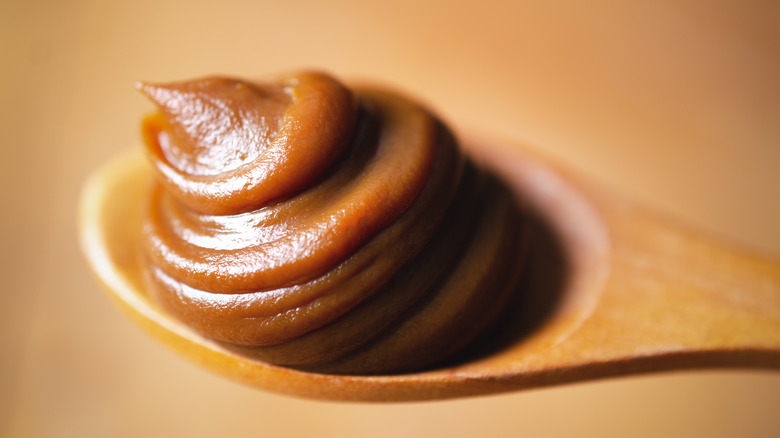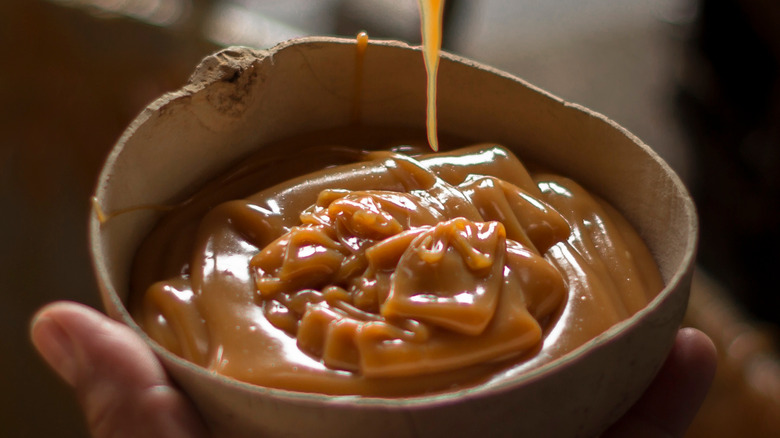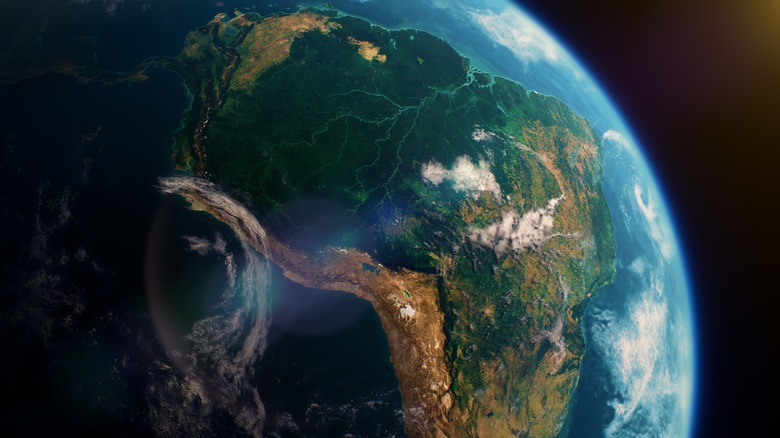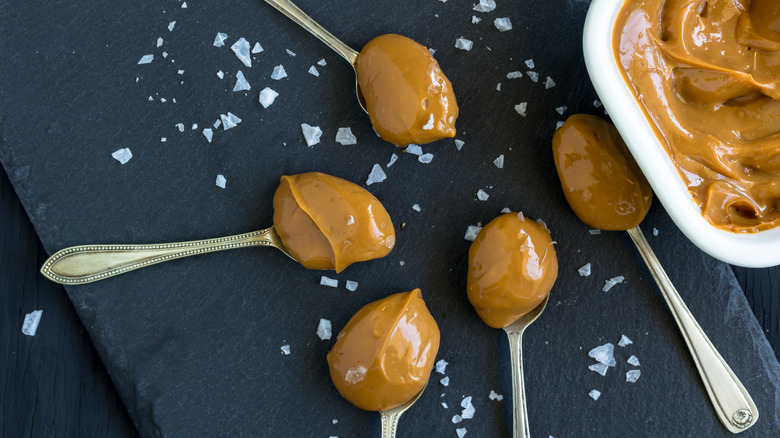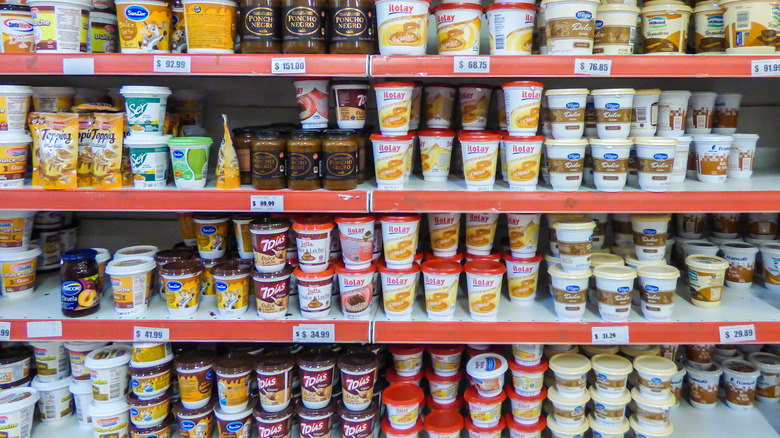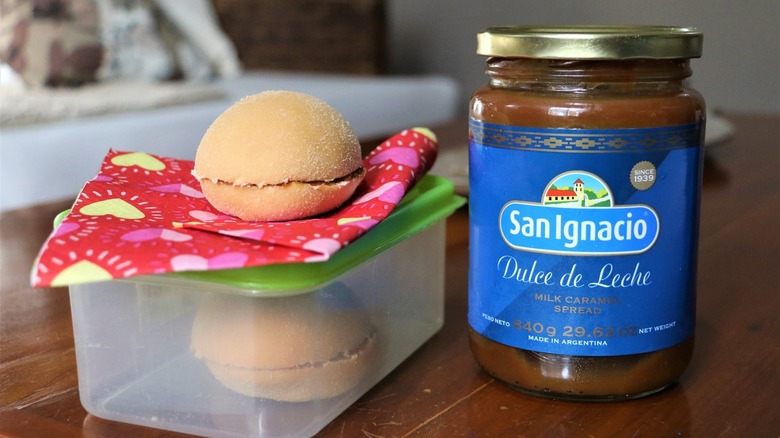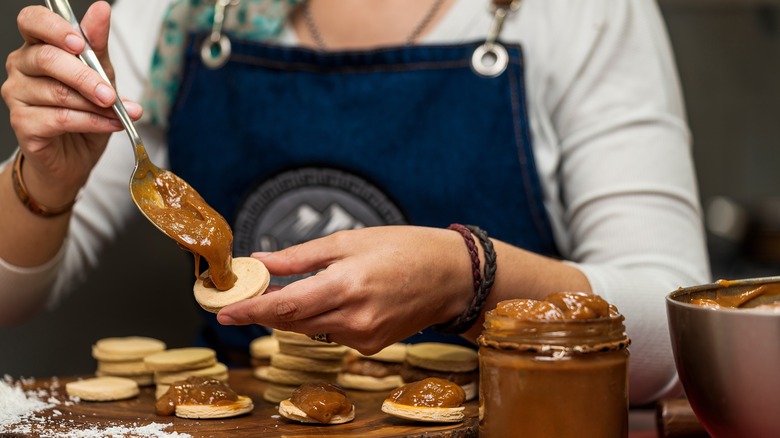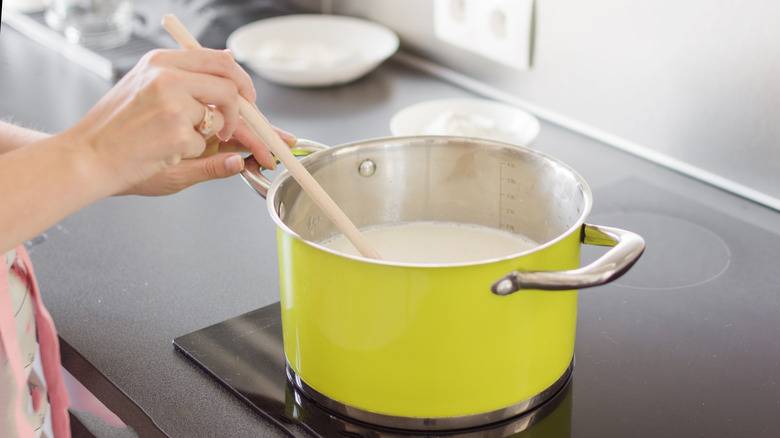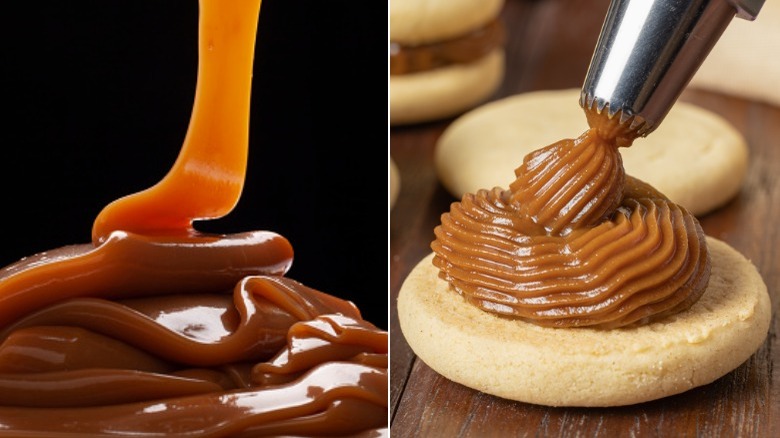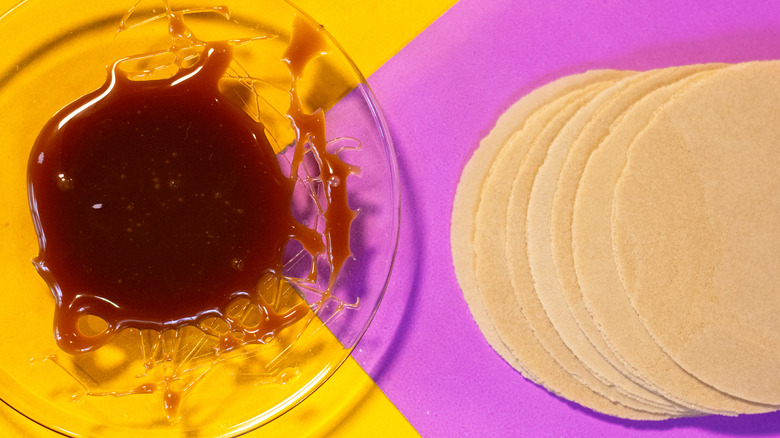The Complete Guide To Dulce De Leche
We may receive a commission on purchases made from links.
Flavors can mean so much more than just how they taste, and that is true for dulce de leche. In 2008, this creamy caramel spread became the subject of "El Dulce de Leche", performed by the French group Tryo. The melancholy tune tells the story of a man, a refugee from Chile, assimilating into French culture. The singer laments the things he misses about his home country: The taste of the meat, friends, family, the Andes Mountains, and, of course, dulce de leche.
Most people can relate to that, even if they have only moved across town, let alone the Atlantic Ocean. There is always that recipe that renews the sensation of sitting at the kitchen table surrounded by love. For many Latin Americans, dulce de leche encapsulates that feeling — it filled childhood birthday cakes and sat atop flan for dessert.
The milky, sweetly smooth flavor of dulce de leche makes it easy to love whether or not you grew up with it. Established fans and curious people hoping to try dulce de leche for the first time can use this guide for some background about the sweet treat, to investigate where to find it, and discover a few recipes that include it.
What is dulce de leche?
Dulce de leche translates literally translates to milk jam — dulce can also mean sweet. If you are wondering how to say it, you could try pronouncing it phonetically, duhl-sey duh leh-chey.
If you have ever made jam before, you know you have to slowly cook fruits with abundant sugar — for example, to make peach jam, you put in about 1 ½ cups of sugar for every 3 or 4 peaches. To make dulce de leche, it is the same idea: You simmer milk slowly with a lot of sugar. After a while, you get dulce de leche. The taste is similar to caramel sauce but creamier and much thicker. People tend to use it more like jam, too, like spreading it on toast.
Dulce de leche is common throughout Latin America. People in Spain, France, and Italy frequently indulge in it as well. You may have tried it before but called it by another name — confiture de lait in France, cajeta in Mexico, manjar in Chile, or arequipe in Colombia.
Where does dulce de leche come from?
It is strange to think that something as sweet as dulce de leche could cause conflict, but in 2003, it was the source of international controversy. People disputed its origin. Argentina tried to declare it a cultural heritage, saying dulce de leche was part of its culinary patrimony.
Neighboring Uruguay felt outraged as it also considers dulce de leche a traditional part of its cuisine. Uruguay worried that Argentina would make a similar declaration to UNESCO, and that could mean Uruguayan manufacturers of dulce de leche would have a harder time placing their products in the international market, that would also mean the world might view only Argentinian dulce de leche as genuine. Argentina could try to establish something like a protected designation of origin similar to Spain's Pimentón de La Vera or France's Champagne.
Uruguay took a preventative step by asking UNESCO to recognize dulce de leche, along with empanadas and asado, as part of the cultural patrimony of the Rio de la Plata region. This river separates the two countries and the capitals of both countries, Montevideo and Buenos Aires. Ironically, neither country invented the treat. Some scholars say the first people to make a dish similar to dulce de leche most likely lived in Southeast Asia. The Spanish colonized both the Philippines and Latin America around the same time. Exporters took the sweet treat from Asia and spread it to the Americas.
The legends surrounding dulce de leche
Although no one knows who invented dulce de leche, for sure, people love telling stories about it. In Argentina, they attribute the discovery to two founding fathers who were also opposing political forces. They met to negotiate an accord to end a civil war. As they argued, their cook forgot some sweetened milk she was heating on the stove — probably because things were getting tense. Her preparation slowly reduced to dulce de leche.
Thus, one day, in 1829, Argentina found both peace and the recipe for dulce de leche. It is a compelling story, but false. Letters dated 1814, 15 years earlier, already mentioned the dessert. Some people say General San Martín tried dulce de leche after crossing the mountains into Chile circa 1817.
Other sources tell a story about Napoleon Bonaparte's cook. In 1804, she forgot some milk with sugar on the stove, and voilà — confiture de lait. That is 25 years earlier than the Argentinian cook, but there is not much evidence to prove this story either. Story-tellers have dragged Marco Polo into the fray, as well. Perhaps, he described dulce de leche when he wrote about a sweetened milk paste eaten by the Tatars from what is now Russia in the 13th century. Like so many other foods, the contradictory myths surrounding origins are fun to read and tell, but no one will ever know the truth.
Who eats the most dulce de leche?
While other facts about dulce de leche may not have much hard evidence to back them up, there are reliable statistics showing which country consumes the most. The Argentinian Observatoria de la Cadena Lactia, or Dairy Chain Observatory, says the country consumed around 83,000 tons of dulce de leche in 2017. That comes out to about 4.4 lbs per person when you divide it amongst the population of 45 million.
To put that in perspective, the National Peanut Board says the average person ate 7.9 lbs of peanuts in 2020 and around half of that is estimated to be a form of peanut butter. In other words, Argentinians eat more dulce de leche than Americans eat peanut butter. Chileans also eat a lot of dulce de leche. According to the Oficina de Estudios y Politicas Agrarias, or The Office of Studies and Farm Policies, Chile produced about 30,000 tons of manjar for the local market in 2014. That comes out to about 3.3 lbs for each of Chile's 20 million residents.
If eating copious amounts of dulce de leche is a competition, though, Uruguay is the winner. The country produced around 17,000 tons for local consumption in 2019, according to El Ministerio de Ganaderia, Agricultura y Pesca, or the Ministry of Livestock, Farming, and Fishing. Divide that by Uruguay's population of 3.5 million, and it comes out to an incredible 10 lbs per capita. That is a lot of dulce de leche.
Where can you find dulce de leche?
Perhaps you have had a craving for dulce de leche but could not find it at your local supermarket. Try searching for it at specialty international food shops that might carry it. Latin American restaurants offer desserts with it. And some major grocery store chains, like Kroger and Meijer, sell dulce de leche at specific branches. If you are still at a loss, do not worry — you can order it online via Amazon or Walmart.
Walmart's website offers some traditional brands of dulce de leche from Argentina: Havana, Cachafaz, and La Serenisima Estilo Colonial for between $10 and $25 the jar. Amazon, on the other hand, has one of Uruguay's favorites, Los Nietitos. You'll find Colombina from Colombia and Nestlé's La Lechera, as well.
The very best way to get ahold of some dulce de leche, though more costly, is going on vacation to a South American destination. On the plane ride down, an individual serving will come with a roll for breakfast. Then, your hotel will likely offer you a little bowl of dulce de leche and some toast first thing every morning. Finally, you'll discover a whole section in the supermarket dedicated to the spread. Imagine yourself on the beach in Uruguay's Punta del Este with a jar of dulce de leche and a spoon. On the other hand, you could head to the ski slopes just outside of Santiago, Chile, but pick up a sachet of manjar first to keep you comforted.
Which brand of dulce de leche tastes the best?
When one of Argentina's main newspapers, La Nacion, interviewed chefs about their favorite brands of dulce de leche, the responses were surprising. All three agree Lapataia is one of the best, which comes from Uruguay. However, you cannot find Lapataia on Amazon. So, instead, here's a mini ranking of the brands you might find on there.
First up, we have Goya, a U.S. company founded by Spanish immigrants in the 1930s, which specializes in foods from Mexico, the Caribbean, Central America, and South America. Goya's dulce de leche comes in a squeeze bottle, similar to those for sundae toppings. On Amazon, it received a ranking of 3.6 stars. One commenter said, "It doesn't taste like Dulce de Leche."
You can also try Colombina, from Colombia. It got its start as a sugar factory in the early 1900s. Later, the company expanded into making candy and, then, arequipe or dulce de leche. This product, sold in a plastic tub, got an average of 4.3 stars. One Amazon review said, "Great product. Tastes like what my Argentine mother used to make."
There are also tin cans of La Lechera by Nestlé that got 4.5 stars. People who bought this brand liked it because they said it was cheaper than other alternatives but tasted about the same. Finally, our favorite, San Ignacio. It is an Argentinian dairy company dating back to 1939. They produce a variety of cheeses in addition to dulce de leche. Their product comes in a glass jar, and consumers rated it 4.6 stars.
How do you use dulce de leche?
Imagine you are in Argentina, and it is tea time or, as the locals say, merienda. The kids are just home from school, still wearing their white guardapolvos, traditional school uniforms that look a bit like mini lab coats. Mom warms up some coffee with milk and puts out some toast and a tub of dulce de leche on the table. Everyone spoons out dulce and spreads it on their bread. This is pretty common in Argentinian households — but perhaps in different orders.
Dulce de leche on bread is the simplest way to eat it, but there are many more options. For example, it is the most traditional filling for an alfajor, a kind of cookie sandwich that may or may not be dipped in chocolate. Other people use it between layers in a cake or instead of frosting on the top. Some dulce de leche is so thick that it can be shaped into beautiful little swirls, spirals, and flowery decorations. It looks particularly enticing on the Argentinian pastries called facturas.
Dulce de leche is also a fantastic topping for ice cream, flan, and pudding. Each of these desserts also comes flavored like dulce de leche. If that sounds good, you might want to try Häagen-Dazs' version. There is no limit to the possibilities if you get creative with dulce de leche. Pair it with brownies or peanut butter, or mix it with melted chocolate. You will not be disappointed.
How do you make dulce de leche?
At first glance, the recipe for dulce de leche is simple — it only has four ingredients. It is not easy to get right, though, and if you live someplace where you can purchase it with relative ease, you'll probably want to skip the trouble.
If you insist on homemade, your first step is to take a quart of milk, a cup of sugar, a teaspoon of vanilla, and a teaspoon of baking soda. Mix them in a saucepan. Then, stand there and stir it for 2 hours while it reduces. Keep it simmering, but do not let it boil. If it does, remove it from the heat immediately — you do not want to incorporate air into the mix.
If you put three marbles in the pot, they'll move around and keep the milk from scorching on the bottom. If dulce de leche burns on the bottom, it spreads an unpleasant taste through the whole batch and ruins it. Remove it from the burner when it is about as thick as pudding. Keep stirring for another 10 minutes so a skin does not form on top.
This recipe requires patience and constant attention. If you look away, your dulce de leche will boil over, burn, get lumpy, or overcook. After two hours of dedication, you could end up with a rock-hard mess stuck to the bottom of your favorite pot.
Different types of dulce de leche
If you have ever searched for dulce de leche at a grocery store, you may have wondered which type to buy. There are different kinds, even though they look almost the same. One might say repostero, while the other has clasico written across the front. You have probably discovered the two main varieties of dulce de leche — the one you buy should depend on what you plan to use it for.
Repostero means pastry or baking, and this type of dulce de leche is thicker and more substantial. If you scoop up a spoonful, it will not dribble off. You can load it into a frosting tool to squeeze out different designs. To get this texture, the mixture can contain cornstarch, making it darker and, at times, a little grainy. This variety of dulce de leche is best for filling and decorating cakes because it holds its shape.
The classic type of dulce de leche is usually a little cheaper than repostero. Its texture is smoother, and it looks shinier. If you scoop up a spoonful, it will run off, similar to honey. This type of dulce de leche is perfect for spreading on crêpes or spooning over ice cream and flan.
Difference between Mexican Cajeta, caramel, and dulce de leche
You may be thinking that dulce de leche sounds like some kind of overrated caramel, but as we've seen, it is more than that. It is a lot like caramel and another kind of milk-based spread from Mexico, cajeta, but the recipes for each sauce or spread are different, as well as the way people use these products.
While dulce de leche is made from milk and sugar, the recipe for homemade caramel incorporates butter, cream, and sugar. It is also much quicker to make: It takes just around 15 minutes. Caramel is usually either very thin, like a sauce, or thick, like taffy. When people eat caramel, it is probably by dipping apples in it, dribbling it over dessert, or mixing it into coffee.
Cajeta is more similar to dulce de leche than caramel, but it is made with goat's milk. The recipe also includes cinnamon which is a big difference from the dulce de leche from Chile, Argentina, and Uruguay. People use cajeta like dulce de leche to cover cakes, but they also make sturdier candy with it, a lot like caramels.
